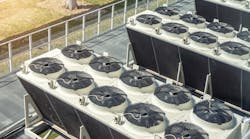Temperature has often been the first thing people think about when considering the air inside a building. But that’s changing as commercial facility managers are understanding the impact air quality has on occupant health and performance.
For example, the National Center for Biotechnology Information estimates that airborne respiratory infections, such as the flu, can cost an average of $20 million in workplace productivity each year, while asthma and allergies cost an additional $29 billion. With many people spending as much as 90% of their time inside buildings, it’s no surprise that indoor air quality (IAQ) has a direct impact on how we feel, engage, learn and work.
Adding to the challenge, the Environmental Protection Agency (EPA) reports longer and more intense allergy seasons with even more tree, grass and weed pollens making their way indoors through open windows and unfiltered vents, or on clothing and hair.
A New Focus on Indoor Air Quality
Several recent studies that point to the benefits of high-quality indoor air have helped raise public awareness of IAQ. Likewise, many building owners have recently invested in improving their IAQ to help curb the spread of airborne viruses and keep occupants healthy.
For building owners to make informed decisions about managing IAQ, it’s important to understand how the air people breathe affects their experience and contributions in a space. Along with the prevention of respiratory disease transmission, any IAQ focus should include an awareness of how it affects overall occupant health, safety and comfort.
Improving IAQ is not only the right thing to do for employees, but it can also strengthen your facility’s bottom line, boost sustainability efforts, and increase your company’s competitiveness when recruiting new employees. Approaching IAQ with a well-considered, bottom-up plan that creates a safer, healthier workplace can have a direct impact on productivity—a recent study from Johnson Controls suggests this can generate a return on investment in the range of $750 to $800 per employee per year in the United States—in addition to energy savings of up to 40% when using the right technologies.
The Effect of Poor IAQ on Health and Productivity
From pollen to pollution, indoor air contaminants can impact anyone, with detrimental effects including seasonal flu, allergies or asthma. Symptoms like cough, headache and poor concentration can be disruptive and, in the case of a virus, easily spread to other workers.
As a result, poor IAQ can affect employees’ attendance as well as their safety. Indoor air contaminants can also decrease employee comfort and make it harder for them to focus and collaborate on complex tasks. For employers, problems with IAQ can lead to absenteeism, presenteeism (working while sick), reduced employee retention and lower productivity. In manufacturing facilities, the results can also be measured in reduced output. Some studies estimate factors like viruses, asthma and allergies can trigger a productivity loss of $45 to $93 per employee per year. Good IAQ reduces exposure to contaminants in the environment that can spread respiratory illness or trigger allergy and asthma symptoms.
Workers who feel healthy and comfortable may be more likely to want to return to a space every day. And, when people feel better, they often perform better. A 2021 Lancet report explains that, in addition to decreasing respiratory symptoms, ventilation and air cleaning improvements likely lead to improved performance and better cognitive function. Another study found office workers’ cognitive function improved 61% when working in a green building (CO2 level of ~750ppm, and TVOC level of 45 µg/m3) versus a conventional building (CO2 level of ~950ppm, and TVOC level of 550 µg/m3) with the greatest benefits for tasks like crisis response, information usage and strategy.
IAQ Considerations for the Facility Manager
Today’s buildings are often constructed in an airtight way to save energy on heating and cooling. The consequence of this design is a lack of fresh outdoor air supply. That lack of fresh air means building owners and managers need to find new ways to combat indoor contaminants.
For example, volatile organic compounds can be given off by carpets, furniture, paint and cleaning products. Carbon monoxide can be emitted from fuel-burning furnaces, water heaters and lab equipment. Contaminants also come from our bodies in the form of exhaled carbon dioxide and viruses like COVID-19, measles and the seasonal flu.
The humidity of a space is also a key component of healthy IAQ. When the humidity is too low, it can cause itchy skin and eyes as well as rashes, and it can dry out sinus membranes. When humidity is too high, it can worsen asthma and allergy symptoms and make it easier for dangerous bacteria and mold to grow. Areas like restrooms, kitchens and showers can generate significant moisture and are likely spots for risk factors related to high humidity.
With the ebb and flow of people and seasons, buildings are dynamic systems that change based on their occupancy and usage. That means IAQ is continuously shifting along with the weather, outdoor air quality, number of occupants, time of day and how building systems are performing.
How Smart Building Solutions Improve IAQ
Improving IAQ should be a part of risk reduction in any environmental, health and safety (EHS) plan. However, it’s not enough to purchase new equipment for buildings and trust that air quality will improve. To truly be successful, building owners must first thoroughly assess their building’s air quality to determine where problems may lie. Then, they can more efficiently build a comprehensive, long-term plan to measure, manage and improve IAQ.
To reliably track and continuously optimize the air quality in their buildings, many building owners opt for smart solutions. These smart solutions include systems that allows IAQ experts to review data and provide insights and recommendations on how to improve performance. Buildings—even older ones—can leverage data to improve IAQ and provide a healthier environment for occupants.
Even well-managed buildings can experience periods of poor indoor air quality, and a smart system dynamically adapts to changing conditions in buildings to maintain healthy IAQ. This capability is especially important during time periods when allergy and asthma symptoms are more difficult to manage.
Then there are solutions that go even farther. IAQ subscription services combine technology and science-backed expertise to provide building owners with a long-term, proactive approach to indoor air quality that can address emerging and existing challenges. By using a subscription service, buildings receive a tailored approach to clean air that can also maximize efficiency, energy and cost savings. Some subscriptions can even be bundled with sustainability and building management subscriptions for total building optimization.
By optimizing on indoor air quality using these smart solutions, building owners can uncover other issues and improve building aspects from all angles. Optimized humidity levels, for instance, can reduce or prevent mold growth. Some buildings are under or over ventilated related to their occupancy. Using an IAQ and building management service in tandem, building ventilation can accurately match occupancy.
IAQ Can Drive Energy Savings
Part of a facility manager’s IAQ plan should include considerations around energy usage and ventilation levels. With a measurable and adaptable HVAC strategy that controls ventilation based on carbon dioxide (CO2) levels, ventilation rates can be adjusted as CO2 rises or falls in line with occupancy, saving energy and improving IAQ.
Consider an office that is over-ventilated, or one that is heavily occupied with poor ventilation. The former is wasting energy, while the latter is contributing to health risks and impacting productivity. Packaging an adaptable ventilation strategy with an IAQ assessment delivers a detailed roadmap for IAQ and sustainability, enabling facility owners and managers to maximize their investment in IAQ—and some data suggests employing these smart strategies may also lead to significant energy usage savings.
Easier Breathing for All
IAQ improvements cultivate a healthy environment for all occupants. It’s important for occupants to question how IAQ is managed in their buildings. If it’s not a focus, occupants can bring attention to IAQ to ensure it’s part of future planning and discussion. Cooperation between building management and occupants is essential for success. When the quality of the air everyone breathes is prioritized, everyone benefits.


